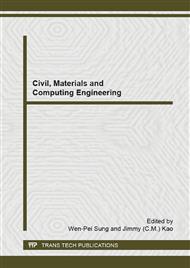[1]
J. Ji, S. Xu. Study on the impact of Sasobit_ on asphalt properties and microstructures. Journal of Materials in Civil Engineering, 2010; 12.
Google Scholar
[2]
J. Ran, S. Xu, M. Li, etc. Research of warm mix asphalt and warm mix asphalt with Sasobit_. In: ICCTP integrated transportation system green intelligent reliable. USA; (2010).
DOI: 10.1061/41127(382)402
Google Scholar
[3]
A. Jamshidi, M. O. Hamzah, M. Y. Aman. Effects of Sasobit_ content on the rheological characteristics of unaged and aged asphalt binders at high and intermediate temperatures. Journal of Materials Research 2012, 15(4): 1-11.
DOI: 10.1590/s1516-14392012005000083
Google Scholar
[4]
B. Samuel, J. Cooper, P. E. Msce. Evaluation of HMA Mixtures Containing Sasobit®[R]. Technical Assistance Report No. 06-1TA, Louisiana Transportation Research Center, July (2009).
Google Scholar
[5]
Sasol Wax. Sasobit® Trade Mark and Application[EB/OL]. http: /www. sasolwax. com/ Sasobit. html and http: /www. sasolwax. com/Sasobit_Technology. Html.
Google Scholar
[6]
Z. F. Hu, G. R. Chen, Y. J. Du. Surface and interface of materials [M]. Shanghai: East China university of science and technology press, (2007).
Google Scholar
[7]
H. Lee, W. Wong. Effect of Wax on basic and rheological properties of bitumen with similar Penetration grades[J]. Construction Build Materials, 2009, 23: 507-514.
DOI: 10.1016/j.conbuildmat.2007.10.020
Google Scholar
[8]
L. Gao, T. Li, H. Xia, et al. Progress in grafted SBS and their applications in asphalt modification[J]. Chemical Industry and Engineering Progress, 2014, 33(7) : 1773-1795.
Google Scholar
[9]
J. Liang, F. Wang. Hydroisomerization of n-Alkane[J]. Progress in Chemistry, 2008, 20 (04), 457-463.
Google Scholar
[10]
Z. R. Pan. Polymer chemistry [M]. Third edition. Beijing: chemical industry press, (2002).
Google Scholar
[11]
S. M. Ho, B. Klesken, L. Zanzotto. Direct Tension Test and Study on Superpave Asphalt Binder Specification—Effect of Wax on Low Temperature Performance of Asphalt[J]. Petroleum Asphalt, 2003, 4, 17, 13-20.
Google Scholar
[12]
G.C. Hurley , B.D. Prowell. Evaluation of Sasobit® for Use in Warm Mix Asphalt[R]. NCAT Report 05-06, National Center for Asphalt Technology, June (2005).
Google Scholar
[13]
A. E. Alvarez, E. Ovalles, S. Caro. Assessment of the effect of mineral filler on asphalt– aggregate interfaces based on thermodynamic properties[J]. Construction and Building Materials, 2012, 28: 599–606.
DOI: 10.1016/j.conbuildmat.2011.08.089
Google Scholar
[14]
Y.M. Yin, X.N. Zhang, G.L. Zou. Investigation into Low-Temperature Performance of Asphalt Mixtures Based on Glass Transition Temperature[J]. Journal of South China University of Technology, 2010, 38 (10), 89-93.
Google Scholar


